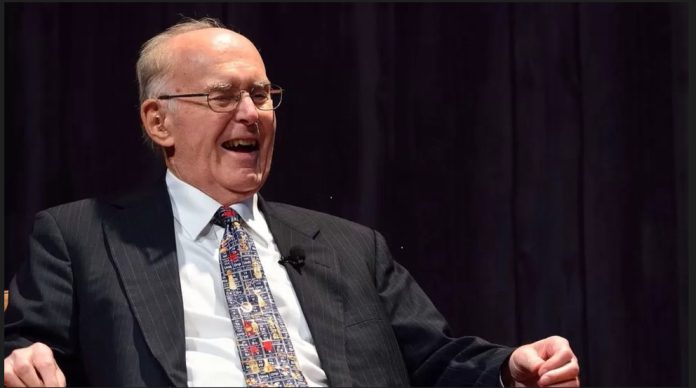Mr Moore started working on semiconductors in the 1950s and co-founded the Intel Corporation. Gordon Moore’s powerful observation about semiconductor chips, commonly known as Moore’s law, became a driving force behind the electronics industry’s rapid development.
Gordon Moore (L) with Robert Noyce (R) founded Intel in July 1968.
Gordon Moore, co-founder of Intel and the man behind Moore’s law, which defined the rate of invention in semiconductors, died on March 24, 2023 aged 94.
Two decades before the computer revolution began, Moore wrote in a paper that integrated circuits would lead “to such wonders as home computers – or at least terminals connected to a central computer – automatic controls for automobiles, and personal portable communications equipment”.
He observed, in the 1965 article, that thanks to technological improvements the number of transistors on microchips had roughly doubled every year since integrated circuits were invented a few years earlier.
His prediction that this would continue became known as Moore’s Law, and it helped push chipmakers to target their research to make this come true.
After Moore’s article was published, memory chips became more efficient and less expensive at an exponential rate.
After earning his PhD, Moore joined the Fairchild Semiconductor laboratory which manufactured commercially viable transistors and integrated circuits.
The expansion of that company lay the groundwork for the transformation of the peninsula of land south of San Francisco into what is now known as Silicon Valley. In 1968 Moore and Robert Noyce left Fairchild to start Intel.
Moore’s work helped drive significant technological progress around the world and allowed for the advent of personal computers and Apple, Facebook and Google.
“All I was trying to do was get that message across, that by putting more and more stuff on a chip we were going to make all electronics cheaper,” Moore said in a 2008 interview.
“Gordon Moore defined the technology industry through his insight and vision,” said Pat Gelsinger, chief executive officer of the California chipmaker behemoth.
“The world lost a giant in Gordon Moore, who was one of Silicon Valley’s founding fathers and a true visionary who helped pave the way for the technological revolution,” Apple’s boss Tim Cook said. “All of us who followed owe him a debt of gratitude.”
“His vision inspired so many of us to pursue technology, was an inspiration to me, said,” Google CEO Sundar Pichai said.
The Intel Corporation paid tribute to its co-founder, saying in a tweet: “we lost a visionary”.
What is Moore’s law?
The earliest version of Moore’s law, published in an issue of Electronics magazine in 1965, read that, “The complexity for minimum component costs has increased at a rate of roughly a factor of two per year. Certainly over the short term this rate can be expected to continue, if not to increase. Over the longer term, the rate of increase is a bit more uncertain, although there is no reason to believe it will not remain nearly constant for at least 10 years.”
If we break it down and try to comprehend it in basic words, it predicted, the number of transistors on a microchip doubles every two years, while the cost per transistor decreases.
What is the significance of Moore’s law?
Moore’s profound revelation, while not technically a law, fuelled competitiveness and a sense of urgency among manufacturers to keep up with the predicted exponential increase. This has led in a continual stream of advancements in computer processing speed and memory storage, spawning new fields of research and companies such as the internet, e-commerce, social media, and mobile devices.
Apple co-founder Steve Jobs had lauded Moore’s law as being a fabulous thing. “It’s really driven the technology industry for the last 30 or 40 years. Microsoft co-founder Bill Gates remarked it is a highly potent force that is propelling the sector to incredible advancements.
Limitations of Moore’s law
Moore’s Law has stood the test for decades, with the number of transistors on a chip increasing at an exponential rate. Yet, once the physical limitations of miniaturisation are approached, some scientists believe that Moore’s law will reach to its limitation.
“We at Intel remain inspired by Moore’s Law and intend to pursue it until the periodic table is exhausted,” however, Intel CEO said.


